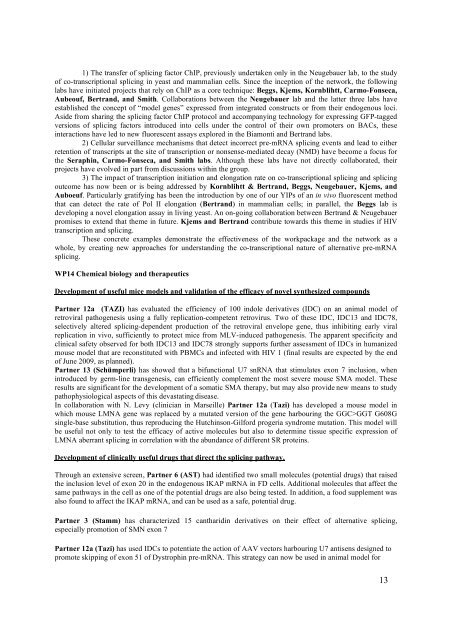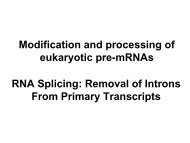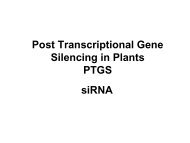You also want an ePaper? Increase the reach of your titles
YUMPU automatically turns print PDFs into web optimized ePapers that Google loves.
1) The transfer of splicing factor ChIP, previously undertaken only in the Neugebauer lab, to the studyof co-transcriptional splicing in yeast and mammalian cells. Since the inception of the network, the followinglabs have initiated projects that rely on ChIP as a core technique: Beggs, Kjems, Kornblihtt, Carmo-Fonseca,Aubeouf, Bertrand, and Smith. Collaborations between the Neugebauer lab and the latter three labs haveestablished the concept of “model genes” expressed from integrated constructs or from their endogenous loci.Aside from sharing the splicing factor ChIP protocol and accompanying technology for expressing GFP-taggedversions of splicing factors introduced into cells under the control of their own promoters on BACs, theseinteractions have led to new fluorescent assays explored in the Biamonti and Bertrand labs.2) Cellular surveillance mechanisms that detect incorrect pre-mRNA splicing events and lead to eitherretention of transcripts at the site of transcription or nonsense-mediated decay (NMD) have become a focus forthe Seraphin, Carmo-Fonseca, and Smith labs. Although these labs have not directly collaborated, theirprojects have evolved in part from discussions within the group.3) The impact of transcription initiation and elongation rate on co-transcriptional splicing and splicingoutcome has now been or is being addressed by Kornblihtt & Bertrand, Beggs, Neugebauer, Kjems, andAuboeuf. Particularly gratifying has been the introduction by one of our YIPs of an in vivo fluorescent methodthat can detect the rate of Pol II elongation (Bertrand) in mammalian cells; in parallel, the Beggs lab isdeveloping a novel elongation assay in living yeast. An on-going collaboration between Bertrand & Neugebauerpromises to extend that theme in future. Kjems and Bertrand contribute towards this theme in studies if HIVtranscription and splicing.These concrete examples demonstrate the effectiveness of the workpackage and the network as awhole, by creating new approaches for understanding the co-transcriptional nature of alternative pre-mRNAsplicing.WP14 Chemical biology and therapeuticsDevelopment of useful mice models and validation of the efficacy of novel synthesized compoundsPartner 12a (TAZI) has evaluated the efficiency of 100 indole derivatives (IDC) on an animal model ofretroviral pathogenesis using a fully replication-competent retrovirus. Two of these IDC, IDC13 and IDC78,selectively altered splicing-dependent production of the retroviral envelope gene, thus inhibiting early viralreplication in vivo, sufficiently to protect mice from MLV-induced pathogenesis. The apparent specificity andclinical safety observed for both IDC13 and IDC78 strongly supports further assessment of IDCs in humanizedmouse model that are reconstituted with PBMCs and infected with HIV 1 (final results are expected by the endof June 2009, as planned).Partner 13 (Schümperli) has showed that a bifunctional U7 snRNA that stimulates exon 7 inclusion, whenintroduced by germ-line transgenesis, can efficiently complement the most severe mouse SMA model. Theseresults are significant for the development of a somatic SMA therapy, but may also provide new means to studypathophysiological aspects of this devastating disease.In collaboration with N. Levy (clinician in Marseille) Partner 12a (Tazi) has developed a mouse model inwhich mouse LMNA gene was replaced by a mutated version of the gene harbouring the GGC>GGT G608Gsingle-base substitution, thus reproducing the Hutchinson-Gilford progeria syndrome mutation. This model willbe useful not only to test the efficacy of active molecules but also to determine tissue specific expression ofLMNA aberrant splicing in correlation with the abundance of different SR proteins.Development of clinically useful drugs that direct the splicing pathway.Through an extensive screen, Partner 6 (AST) had identified two small molecules (potential drugs) that raisedthe inclusion level of exon 20 in the endogenous IKAP mRNA in FD cells. Additional molecules that affect thesame pathways in the cell as one of the potential drugs are also being tested. In addition, a food supplement wasalso found to affect the IKAP mRNA, and can be used as a safe, potential drug.Partner 3 (Stamm) has characterized 15 cantharidin derivatives on their effect of alternative splicing,especially promotion of SMN exon 7Partner 12a (Tazi) has used IDCs to potentiate the action of AAV vectors harbouring U7 antisens designed topromote skipping of exon 51 of Dystrophin pre-mRNA. This strategy can now be used in animal model for13







